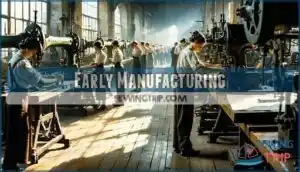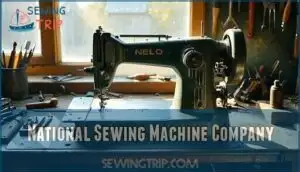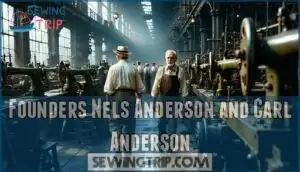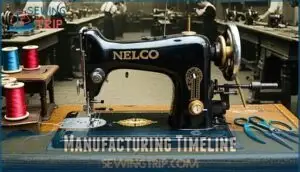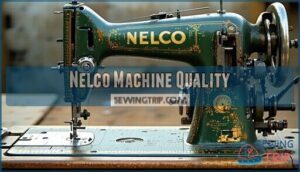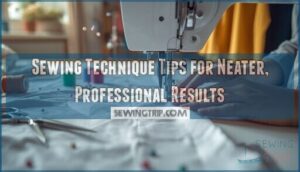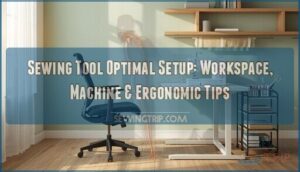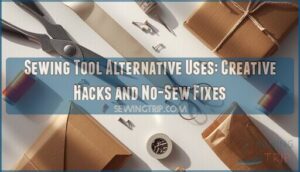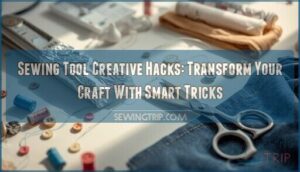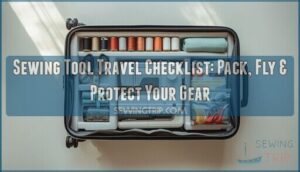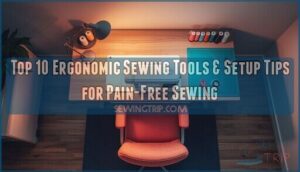This site is supported by our readers. We may earn a commission, at no cost to you, if you purchase through links.
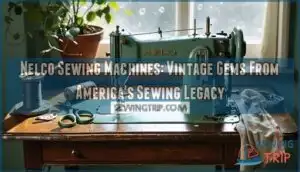
Founded by Nels and Carl Anderson, these machines represented a golden era of American manufacturing, delivering reliable craftsmanship to households across the country.
You’ll discover these vintage gems were produced during a time when home sewing was both a practical skill and a creative outlet.
While their production peaked mid-century, Nelco machines remain prized by collectors and sewing enthusiasts who appreciate their durability and nostalgic charm.
Their legacy continues to spark interest among vintage craft lovers.
Table Of Contents
Key Takeaways
- You’ll find Nelco sewing machines were primarily manufactured from the early 1930s through the early 1970s, with peak production occurring during the mid-20th century under the National Sewing Machine Company and later Singer.
- These vintage machines transitioned from American to Japanese production in the early/mid-1960s, with distinctive markings like ‘JA’ or ‘JC’ indicating their Japanese manufacturing origins.
- You can trace Nelco’s manufacturing timeline through key ownership changes, including the National Sewing Machine Company’s initial production and Singer’s acquisition in 1926, which reshaped the brand’s trajectory.
- If you’re a collector, you’ll discover Nelco machines from this era are now prized for their durability, with models ranging from $50 to $500, depending on condition, rarity, and historical significance.
Nelco Sewing History
You’ll love discovering the rich history of Nelco sewing machines, a vintage brand that emerged from the National Sewing Machine Company in the early 1900s.
From their roots in Belvidere, Illinois, to becoming a beloved sewing companion for generations of crafters, Nelco machines represent an important chapter in America’s home crafting legacy.
Early Manufacturing
When the sewing machine revolution swept America, Nelco’s early manufacturing roots took hold in Belvidere, Illinois.
Nelco’s journey began in Belvidere, Illinois, sparking a home sewing revolution that transformed crafting for generations.
Founded by innovative pioneers like Nels Anderson and his son Carl, the company pioneered home sewing technologies.
Their National Origins strategy focused on creating reliable, affordable machines that would transform domestic crafting, setting the stage for a remarkable manufacturing legacy, built on reliable and affordable solutions.
National Sewing Machine Company
Building on the early sewing machine landscape, the National Sewing Machine Company in Belvidere emerged as a powerhouse of innovation.
Their Nelco machines quickly became industry standouts, setting new standards for manufacturing excellence.
- Pioneered early industrial and home models
- Revolutionized mail-order sales strategies
- Established Belvidere as a manufacturing hub
With Singer’s later acquisition, Nelco’s legacy of quality and precision continued to shape America’s sewing industry.
Founders Nels Anderson and Carl Anderson
By the dawn of the 20th century, Nels Anderson and his son Carl pioneered the Nelco sewing machine legacy.
Pioneering innovation, Nels and Carl Anderson shaped the enduring legacy of Nelco sewing machines with grit and unparalleled craftsmanship.
Their family business emerged from a vision of innovation, tackling early manufacturing challenges with grit and determination.
These machines are considered unsung heroes, offering unique features.
Together, they laid the groundwork for a sewing machine brand that would become a cornerstone of American industrial craftsmanship.
When Made Nelco Machines
The Nelco sewing machine’s journey through time reveals a fascinating chapter in American manufacturing history.
You’ll find these vintage machines were crafted across several distinctive eras, primarily spanning from the early 1900s to the early 1970s.
Keen collectors know the most sought-after Nelco models originated in mid-1960s Japanese factories, often sharing production lines with White and Dressmaker machines.
Distinctive markings like ‘JA’ or ‘JC’ stamped underneath hint at their Japanese roots.
A special Bicentennial model (52A525) even celebrated America’s 200th anniversary in 1976.
The invention of the sewing machine allowed for increased textile production, revolutionizing the garment industry.
Whether you’re a sewing enthusiast or vintage equipment collector, understanding Nelco’s production timeline offers a glimpse into a beloved brand’s rich manufacturing heritage.
Manufacturing Timeline
You’ll want to explore the fascinating journey of Nelco sewing machines, which rolled out of American factories from the early 1930s through the early 1970s under different manufacturers.
From the National Sewing Machine Company to Singer, these vintage machines tell a story of innovation, changing ownership, and American manufacturing prowess that’ll fascinate any sewing enthusiast.
Production Years
From the dusty corners of sewing history, Nelco’s manufacturing journey captivates collectors and enthusiasts.
Their vintage machines emerged with distinctive production characteristics:
- Peak production spanned from the 1930s to early 1970s
- Japanese manufacturing became prominent in the early/mid-1960s
- Initial production roots traced to the National Sewing Machine Company
Their manufacturing timeline reflects an era of American industrial craftsmanship and innovation.
Company Ownership Changes
The winds of change swept through Nelco’s manufacturing landscape as the National Sewing Machine Company’s demise paved the way for Singer’s acquisition in 1926.
Jolson’s Nelco brand navigated complex ownership shifts, wrestling with Necchi and Elna through legal disputes while preserving its manufacturing identity through strategic branding and distribution transformations.
Models and Features
As Singer’s ownership reshaped Nelco’s trajectory, the sewing machine models evolved dramatically.
You’ll find remarkable diversity across their lineup, showcasing engineering ingenuity and adaptability.
- Stitch patterns varied widely between models
- Vertical bobbin systems enhanced usability
- Nylon gears reduced operational noise
- Aluminum construction guaranteed durability
These machines weren’t just tools—they were precision instruments designed to transform fabric into art, with each model telling a unique story of American manufacturing prowess, demonstrating adaptability in their design.
Nelco Machine Quality
If you’re hunting for a reliable vintage sewing machine, Nelco offers durability that’ll impress even the most discerning sewers.
These sturdy Japanese-made machines, produced from the 1930s to the early 1970s, were built to handle everything from delicate silk to heavy denim with remarkable consistency.
Durability and Reliability
In terms of build quality, Nelco sewing machines are the workhorses of the crafting world.
Their robust manufacturing during key Nelco production years guarantees consistent performance across fabric types.
You’ll find these vintage gems surprisingly durable, with quiet operation that speaks to their precise engineering and reliable design from the golden age of sewing machine production.
Some models even offer heavy-duty construction capable of handling thicker materials like denim.
User Experiences and Reviews
When you explore vintage Nelco sewing machine forums, users consistently praise these machines’ fabric handling and stitch quality.
Model comparisons reveal impressive versatility across different Nelco sewing machine models.
Owners share heartwarming repair stories, highlighting how these vintage Nelco machines connect generations of sewers through reliable craftsmanship and enduring performance.
Maintenance and Repair
An old Nelco sewing machine’s heartbeat depends on your tender care.
Regular oiling techniques and thoughtful part replacement keep these vintage workhorses humming.
To maintain peak performance, consider using specialized sewing lubricants for reliable stitching.
Troubleshooting common issues like belt adjustment and motor maintenance isn’t rocket science—just patience and a keen eye.
Your Nelco will reward you with decades of reliable stitching, if you treat it right.
Nelco Availability Today
If you’re a vintage sewing enthusiast hunting for a reliable machine, Nelco sewing machines might be your perfect treasure.
You’ll find these collectible gems ranging from $50 to $500 online, with prices varying based on model condition and rarity.
Collectibility and Prices
After crafting reliable machines, Nelco sewing machines now beckon collectors with their vintage charm.
Your hunt for these treasures reveals fascinating price points:
- Models range from $55 to $120
- Condition dramatically influences value
- Accessories like cases boost pricing
- Rarity determines collector interest
- Investment potential varies by model
Whether snagging a hidden gem at a yard sale or investing thoughtfully, Nelco machines offer a nostalgic journey into sewing history.
You can explore the current Nelco prices online to find the best investment potential and understand how rarity affects the value of these machines.
Rare and Vintage Models
Hunting for rare Nelco sewing machines reveals a treasure trove of vintage craftsmanship. Each model tells a unique story, from the Bicentennial red, white, and blue edition to the elusive Model A-2 with its distinctive serial number.
| Model | Year | Unique Feature |
|---|---|---|
| A-2 | 1960s | Serial #30466756 |
| 6105F | 1970s | Free arm design |
| N-15 | 1980s | Elna Lotus style |
| Bicentennial 52A525 | 1976 | Patriotic colors |
Collectors prize these gems for their historical value and mechanical integrity. Condition and completeness, like original accessories included, greatly affect value. The rare Nelco sewing machines are highly sought after for their unique characteristics and collectibility.
Online Marketplaces and Retail Stores
If you’re itching to snag a Nelco sewing machine, you’re in luck! These vintage beauties are just a click away.
Check out these prime hunting grounds:
- eBay’s treasure trove of rare finds
- Etsy’s curated vintage marketplace
- Facebook Marketplace’s local gems
- Specialized sewing machine collector forums
Prices range from budget-friendly $50 to collector’s $500, depending on the machine’s condition and manufacturing year between the 1930s and 1970s.
You can find Nelco sewing accessories online, which is a great resource for those looking for vintage sewing machine parts or rare accessories to complete their collection, and also for those interested in sewing.
Frequently Asked Questions (FAQs)
How can I tell what year my sewing machine was made?
Check your Nelco sewing machine’s serial number on the base or back.
Compare it with manufacturer records or contact vintage sewing machine collectors.
Online forums and specialized websites can help you pinpoint your machine’s exact manufacturing year.
Who made Nelco sewing machines?
You might stumble upon a Nelco sewing machine and wonder about its creators.
Primarily manufactured by the National Sewing Machine Company, Singer, and Leon Jolson, these Japanese-made machines were distributed by various companies throughout the mid-20th century.
What is the most sought after sewing machine?
You’ll want a vintage Singer Featherweight 221, prized by collectors for its lightweight design, durability, and timeless performance in quilting and sewing circles.
Collectors keenly seek this classic machine for its nostalgic charm and reliability.
What is the oldest brand of sewing machine?
You’ll find Singer Sewing Machine Company holds the title of the oldest sewing machine brand, founded in 1851 by Isaac Singer, pioneering mass production and revolutionizing textile manufacturing worldwide.
Who was Leon Jolson?
Like a phoenix rising from immigrant dreams, Leon Jolson transformed his post-war struggles into a sewing machine legacy.
He founded Nelco by blending Necchi and Elna brands while overcoming complex legal and entrepreneurial challenges.
What kind of lawsuits were filed against Leon Jolson and Nelco?
You’ll encounter legal battles with Necchi and Elna over branding and machine names. Jolson faced multiple out-of-court settlements and trademark disputes stemming from his complex business strategies and naming conventions.
Are there any Nelco sewing machines still in production?
Just as vintage typewriters fade into museum shelves, Nelco sewing machines have long since retired.
You won’t find new models today, but collectors cherish these vintage Japanese-made machines from the mid-20th century.
What is the average lifespan of a Nelco sewing machine?
Your Nelco sewing machine could last 20-40 years with proper maintenance.
Regular servicing, gentle use, and careful storage can extend its life substantially.
Quality craftsmanship means these machines often outlive newer, less durable models, which is a testament to their durability.
Are there any parts of a Nelco sewing machine that are made of plastic?
You’ll find plastic parts on later Nelco models, typically in tension discs, bobbin cases, and some internal components.
Older machines mainly used metal, but manufacturing shifts in the 1960s and 1970s introduced more plastic elements.
Are Nelco Sewing Machines Still Being Manufactured?
Ironically, your sewing dreams won’t be stitched with new Nelco machines. They’ve long stopped production, leaving collectors and vintage enthusiasts hunting for these nostalgic gems from Japan’s manufacturing era.
Conclusion
Woven into the fabric of American craftsmanship, Nelco sewing machines are more than just vintage tools—they’re time capsules of creativity.
When you’re searching for when Nelco sewing machines were made, remember they represent a pivotal era of home manufacturing.
Whether you’re a collector, hobbyist, or history enthusiast, these machines offer a tangible connection to mid-century domestic innovation.
Their enduring legacy reminds us that quality craftsmanship never goes out of style, preserving stories stitch by stitch.

